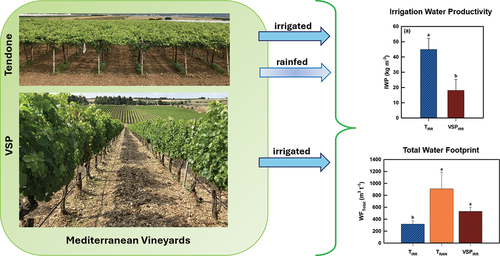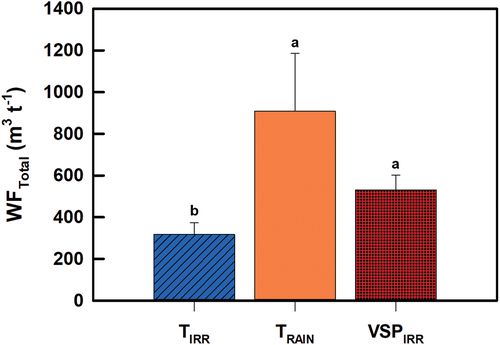 ?Mathematical formulae have been encoded as MathML and are displayed in this HTML version using MathJax in order to improve their display. Uncheck the box to turn MathJax off. This feature requires Javascript. Click on a formula to zoom.
?Mathematical formulae have been encoded as MathML and are displayed in this HTML version using MathJax in order to improve their display. Uncheck the box to turn MathJax off. This feature requires Javascript. Click on a formula to zoom.ABSTRACT
The training system is a valuable strategy to face water resource limitations under climate changes as its canopy architecture influences evapotranspiration losses and both water productivity (WP) and irrigation water productivity (IWP). Detailed information on them (yield per unit of water) would support the choice of the training system. This study compared the water productivity in 38 irrigated (IRR) and rainfed (RAIN) vineyards trained at tendone (T, n = 30) and vertical shoot positioning (VSP, n = 8). The green, blue and grey volumetric water footprints (WFs) were also employed to characterize T and VSP. At harvest, grape quality traits (pH, sugars and potassium concentrations) were examined too. The mean (±SE) IWP in TIRR reached 45.0 ± 7.2 kg m−3 being approx. 2.5-fold than that in VSPIRR. Furthermore, TIRR showed 60% (WFgreen) and 30% (WFblue) lower than VSPIRR. Findings show the attitude of TIRR in valuating water resources with no significant impact on grape quality. This study integrates the set of knowledge to be evaluated for training system choice managing the trade-offs between yield, grape quality and water productivity triggered by climate change.
Introduction
According to IPCC et al. (Citation2022), semi-arid regions around the world are increasingly facing significant challenges related to climate change. Indeed, these regions are projected to become drier, which will lead to more frequent and severe droughts. Water scarcity and in turn drought events are expected to worsen due to decreasing annual precipitation and increasing air temperature (Lionello and Scarascia Citation2018). This trend is expected to have significant impacts on agriculture, which is a major user of water. According to IPCC et al. (Citation2022), Mediterranean Europe is already experiencing water scarcity and facing significant challenges related to agriculture water management. In addition, water scarcity in Mediterranean areas, as well as other semi-arid regions worldwide, will likely lead to changes in crop species and irrigation practices, adopting more drought-tolerant ones and implementing water-saving technologies (IPCC et al. Citation2022). However, in case of relevant socio-economic species such as Vitis spp. (a global surface area equal to 7.3 million of hectares according to OIV Citation2023), substitution is not easily feasible (Naulleau et al. Citation2021)
Irrigation commonly compensates for soil water content to satisfy plant needs; therefore, it affects canopy development, yield and fruit composition. Hence, a lack of water could determine the restriction in terms of vegetative and reproductive growth (Kramer and Boyer Citation1995). Several strategies have been used in recent decades to adapt to environmental constraints resulting from climate change (e.g., PRD, RDI, priming, leaf thermoregulation) (Flexas et al. Citation2010; Montanaro et al. Citation2022) become pivotal also to keep grape and wine quality (Chaves et al. Citation2007).
It is worth to notice that grapevine is a drought tolerant plant, cultivated since millennia in arid and semi-arid regions of Asia, Europe and Africa (Dong et al. Citation2023). Besides the selection of drought tolerant scion (Lovisolo et al. Citation2010) and rootstock (Bianchi et al. Citation2018), the vineyard management techniques could significantly affect the water productivity (WP), resulting in key adaptive responses. Among them, the training system, modifying the plant architecture, significantly impacts the vegeto-productive performances and water use of vineyards (Reynolds and Heuvel Citation2009; Del Zozzo et al. Citation2024).
In the Mediterranean and semi-arid areas, in order to avoid water waste, it is mandatory to find management strategies able to optimize the water use efficiency (WUE) (Medrano et al. Citation2015). For this purpose, several approaches were developed for measuring grapevine water status and WUE (reviewed in Medrano et al. Citation2015) that can be determined at different scales. For example, Medrano et al. (Citation2015) identified the following: leaf scale (Net leaf photosynthesis/transpiration or stomatal conductance), watershed scale (yield/water used), plant (biomass/water loss) and vineyard scales (yield/water used, WUEcrop). WUE reflects a balance between ‘gains’ and ‘costs’ (Tomás et al. Citation2014). It is worth to notice that WUE can be analyzed at different spatial/temporal horizon (Medrano et al. Citation2015) and vineyard conditions (e.g. irrigation management, soil humidity content, meteorological conditions (Balbontín et al. Citation2015)). Although the WUEcrop is suitable to analyze the influence of management practices (Sadras Citation2009; Williams et al. Citation2010), it is difficult to be employed at commercial scale due to the uncertainties in determining the vineyard water used accounting for the amounts of water losses (e.g., evaporation, run-off, leaching etc.) (Sadras Citation2009; Medrano et al. Citation2015). Hence, the ‘irrigation water productivity’ (IWP) (yield per unit of applied irrigation water) has been suggested to measure the irrigation efficiency at commercial scale (Sadras Citation2009) gathering the concept from the water productivity (WP) mostly expressed as the ratio of ‘biomass to evapotranspired water’ as reviewed in Steduto et al. (Citation2007), which reported that WP is also referred to as WUE in the literature.
Due to the increased necessity of mechanization, some trellises well adapted in semi-arid viticulture areas, such as Gobelet and horizontal canopy systems like Pergola and Tendone, have been replaced by vertical shoot positioning (VSP) ones, pruned as spur cordons or Guyot (Kurtural and Fidelibus Citation2021). Although VSP has some limitations in facing climate change challenges being prone to radiative stress and heat wave (Gutiérrez‐Gamboa et al. Citation2021), it is widely adopted in different environments. The tendone (T) training system is widely adopted in warm/dry environments offering bunch and soil shading, which are in favour of grape quality and evaporation reduction being valuable traits in Mediterranean areas (Xyrafis et al. Citation2023).
The T and VSP training systems differ in various agronomical traits including bud load per hectare, total leaf area, shaded/exposed leaf ratio leading to different yield and water requirement (Pastena Citation1990). It is also reported that they differ in terms of water consumption, while the production could be comparable depending on the vintage (Giorio and Nuzzo Citation2011; Silvestroni et al. Citation2019, Citation2020; Alba et al. Citation2022). Following this, it could be argued that the T and VSP have a different WP at vineyard scale.
To account for the environmental and socio-economic impacts of the agrifood production, the concept of ‘virtual water’ has been worldwide introduced quantifying the volume of water used to produce a commodity (Allan Citation1998). In line with this, the water footprint (WF) is defined as the volume of water used per unit of food produced safeguarding water resource (Mekonnen and Hoekstra Citation2011). Hoekstra (Citation2011) proposed an operational WF scheme splitting the volumes of water used along the production chain into three fractions: green (the rainwater consumed for crop yield), blue (the irrigation water consumed for crop yield) and grey (the freshwater required to assimilate pollutants). The above green, blue and grey volumes of water normalized per unit yield translate into WFgreen, WFblue, WFgrey (usually m3 water t−1 yield), respectively (Hoekstra Citation2011).
The various WFs calculated as above give volumetric data about the virtual water requested for production as well as its impact on local and global water resources (Mekonnen and Hoekstra Citation2011). Within the agriculture context, WFs have been applied to estimate the socio-economic environmental impact of various crops including apple, orange, peach, cotton and grapevine (Mekonnen and Hoekstra Citation2011). Hence, the use of WF to compare the efficiency of water use in different training systems might provide additional information on their environmental impact, aiding the selection of the best adaptive one in a challenging viticulture scenario worldwide (IPCC et al. Citation2022). On this background, the work aims at comparing the IWP and WFs in T and VSP vineyards. The results provide new insights about adaptative strategies in growing grapes through assessing the impact/role of training system on water as crop (IWP) and environmental (WFs) valuable resources.
Materials and methods
Viticulture experimental design
Thirty-eight vineyards (cultivar ‘Montepulciano’) belonging to private farms were located in coastal (min. distance from the sea: 1.5 km) and hilly areas (max distance from the sea: 20 km) of the Molise region (South-East Italy). The vineyard elevation ranged from 15 m to 546 m asl. The studied area is shown in , while details concerning the vineyards (location; training system; pruning, irrigation and soil management; area and plant distribution; grape production) are reported in Supplementary materials (Table S1, S2 and S3; Figure S1). Briefly, 30 T (vine density from 1600 to 2800 vines ha−1) and eight VSP (vine density from 2666 to 9259 vines ha−1) vineyards were studied. The training systems were characterized by a cane pruning management. Twenty vineyards (18 T and 2 VSP) were rainfed, while the other 18 were irrigated in June, July and August according to the local irrigation scheduling.
Figure 1. Overview map of the study area. Within the inset the map of Italy, highlighting in yellow the Molise region. In the digital terrain model of the region the red rectangle indicates the area pertaining the studied vineyards.

According to the local commercial practices, at harvest time (from 22nd Sept. to 15th Oct.), per each vineyard the yield was obtained by weighting the total grape production (by the means of a standard platform scale, Bilanciai D 800, 1.0 kg – Barletta, Italy) upon delivery to the cellar of the cooperative winery ‘Cantina San Zenone’. Must samples from different points (at least 3) for each trailer were automatically collected using a vertical screw inserted into a steel tube. Sugar concentration (°BABO) and pH of the must samples were determined using a multiparameter analyzer (Maselli sm-02, Maselli Misure S.p.A. Parma, Italy). The sugar yield (t ha−1) was obtained multiplying the grape yield per the sugar concentration of grapes. Total anthocyanins (mg L−1), total phenolic compounds (mg L−1) and potassium (mg L−1) were determined using a sequential enzymatic analyzer, Y15 from BioSystems (Barcelona, Spain). The Y15 equipment was calibrated with the external standards that are provided in every kit by BioSystems.
Water productivity (IWP) and water footprint (WF)
The irrigation water productivity (IWP) was calculated as the ratio between yield (kg ha−1) and the volume of irrigation water supplied to each vineyard (m3 ha−1), according to Sadras (Citation2009).
The total water productivity (WPTOTAL) was calculated as the ratio between yield (kg ha−1) and the sum of the rainfall + irrigation volumes (m3 ha−1).
The volumetric WF was calculated according to Hoekstra (Citation2011) and partitioned in the ‘green’, ‘blue’ and ‘grey’ component as follows:
The rainfall volumes used in the EquationEquations 2(2)
(2) and Equation3
(3)
(3) refer to the total annual rainfall (m3 ha−1) of the area pertaining the vineyards according to their elevation (Figure S1).
According to Mekonnen and Hoekstra (Citation2011), in EquationEquation 5(5)
(5) , the grey WF is related to nitrogen (N), AR represents the annual N application rate (kg ha−1), α represents the fraction of AR assumed to be lost via leaching or run-off (10%), Cmax is the maximum acceptable concentration of N in the water body (kg m−3), Cnat is the natural concentration of N in the receiving water body which was assumed to be zero. Following Mekonnen and Hoekstra (Citation2011), Cmax was set to 10 mg L−1. The AR in each vineyard was related to the fertilization plan receiving 45, 30 and 25 kg ha−1 when under mineral, organo-mineral and organic fertilization, respectively. Four vineyards did not receive N. The sum of the three WF components represents the total WF (WFtotal).
Data analysis
Vineyard groups were compared by using the Student’s t-test after checking for the normality distribution of data (Shapiro – Wilk’s test); in case of failure of the test, the non-parametric Mann-Whitney’s U-test was used. Values of p lower than 0.05 were considered significant. Data analysis, fitting curve and plotting were by Sigmaplot 12.3 (Systat Software Inc.).
Results
The meteorological data collected from the various weather stations provide the seasonal pattern of the precipitation and temperature throughout the analyzed area according to their elevation a.s.l. (). Annual and seasonal (JJA) mean rainfall and temperature are reported in Supplementary material (Table S2).
Figure 2. (a) Monthly minimum (solid blue line), mean (solid black line) and maximum (solid red line) temperatures for the year 2022. Dotted lines represent the average temperatures for the period 1991–2020. (b) Monthly cumulative precipitation at different elevation (from <200 to >600 m asl) during 2022. The light blue bar represents the average cumulative precipitation for the period 1991–2020. (c) Distribution of wind speed (Ws; m s−1) and direction measured during 2022.
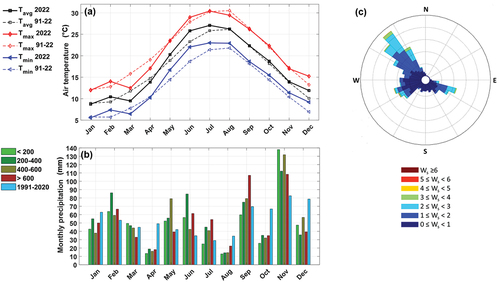
Yield and grape composition
The yield in T ranged from 0.9 to 47.6 t ha−1, while it varied from 7.5 to 23.7 t ha−1 in VSP (Figure S1). The vines under irrigation received on average 665 ± 106.8 and 697 ± 226.3 m3 of water per ha in T and VSP, respectively (Table S3).
Regardless of the training system, the concentration of the total anthocyanins was significantly low in irrigated fields being approximately 60 and 104 mg L−1 in irrigated and rainfed vineyards, respectively (). Similarly, total polyphenols were significantly influenced by treatment reaching approx. 780 and 1130 mg L−1 in irrigated and rainfed vineyards, respectively (). The sugar concentration (~20 °BABO) and the other analyzed traits were comparable in irrigated and rainfed vineyards (). When analyzed regardless of the training system, the irrigation significantly affected the yield reaching 20.36 ± 12.39 t ha−1, while it was 13.03 ± 9.45 t ha−1 in rainfed plots (). When analyzed regardless of the water source (irrigated, rainfed), the training system did not significantly influence the analyzed traits ().
Table 1. Mean (± SD) yield and measured grape quality traits (sugar, pH, potassium, anthocyanins and total polyphenols) in irrigated and rainfed vineyards regardless of training system (*indicates significant differences; ns, not significant at, p = 0.05). Note that the comparison of yield and total anthocyanins employed Student’s t-test, while sugars, pH, potassium and total polyphenols were compared using the Mann-Whitney U-test).
Table 2. Mean (± SD) yield and measured grape quality traits (sugar, pH, potassium, anthocyanins and total polyphenols) in Tendone and VSP vineyards regardless water management (ns, not significant at, p = 0.05). Note that the comparison of yield and total anthocyanins employed Student’s t-test, while sugars, pH, potassium and total polyphenols were compared using the Mann-Whitney U-test).
Irrigation water productivity (IWP)
The average (±SE) annual volume of irrigation water received by the vineyards was 664.7 ± 106.8 in TIRR and 1002.2 ± 226.3 m3 ha−1 in VSPIRR and was statistically comparable (Student’s t-test, α = 0.05).
The average IWP in irrigated T vines (45.0 ± 7.2 kg m−3) was significantly higher with respect to irrigated VSP ones (18.1 ± 7.1 kg m−3), as shown in . When the efficiency of water used accounted for the sum of irrigation + rainfall volumes (WPTOTAL), it showed significant differences among TIRR (4.4 ± 0.7 kg m−3), TRAIN (2.5 ± 0.5 kg m−3) and VSPIRR (2.2 ± 0.3 kg m−3) vineyard groups .
Figure 3. (a) Irrigation water productivity (IWP) calculated in both irrigated Tendone (TIRR) and irrigated vertical shoot positioning (VSPIRR) vineyards. (b) Total water productivity (WPTOTAL) calculated in irrigated Tendone (TIRR), rainfed Tendone (TRAIN) and irrigated vertical shoot positioning (VSPIRR) vineyards. Different letter indicates statistically significant difference (p < 0.05).
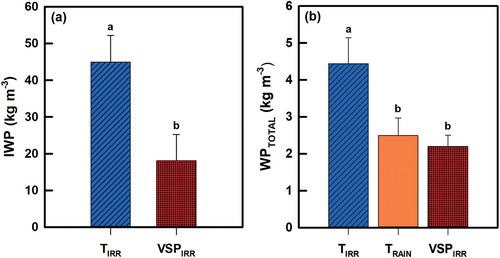
Results on the volumetric WF show that the WFgreen reached 267.1 ± 47.3, 842.1 ± 251.0 and 404.4 ± 50.3 m3 t−1 in TIRR, TRAIN and VSPIRR, respectively (). As concerning WFblue, TIRR displayed a significantly lower value of 32.4 ± 6.1 m3 t−1 against that in irrigated VSP which reached 96.7 ± 22.4 m3 t−1. The WFtotal was significantly lower in TIRR (318.3 ± 55.8 m3 t−1) than TRAIN (908.9 ± 276.8 m3 t−1) and VSPIRR (530.5 ± 71.4 m3 t−1) ().
Figure 4. Green, Blue and Grey Water Footprint in irrigated (TIRR) and rainfed tendone (TRAIN) and irrigated vertical shoot positioning (VSPIRR). Comparing the same water footprint category, different letter indicates significant differences across all groups (p < 0.05). The Y-axis has been broken from 120 to 200 m3 t−1.
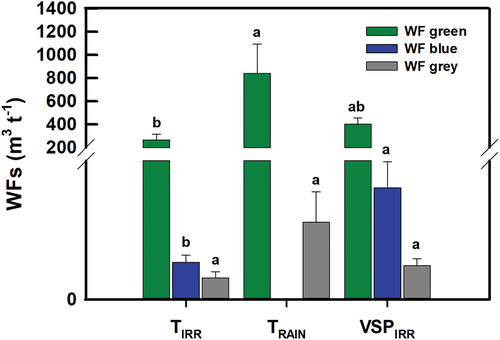
Discussion
This study compared the water use in two training systems that received water through irrigation and/or precipitation, assessing (i) the irrigation water productivity (IWP) (Sadras Citation2009) and (ii) the volumetric water footprint (WF) (Hoekstra Citation2011). Findings documented that T and VSP did not have a significant impact on grape quality traits and that TIRR significantly increased IWP by approx. 60% when compared to VSPIRR. The analysis also revealed that the socio-economic impact was minimized in TIRR (i.e., lowest WF). Hence, the present study contributed to characterize these systems which are relevant trellises for the grapevine industry in Mediterranean environment (de Palma and Novello Citation2003; Giorio and Nuzzo Citation2011; Vanino et al. Citation2015; Gutiérrez‐Gamboa et al. Citation2021; Alba et al. Citation2022; Del Zozzo et al. Citation2024).
The relatively high number of vineyards analyzed in the present study and their distribution over a large and variable area (e.g., elevation range) support the reliability of the outcomes. Environmental conditions might influence water consumption and yield (Gutierrez-Gamboa et al., Citation2021) and therefore might be influential on IWP and WF (Balbontín et al. Citation2015). The mean air temperature and the rainfall recorded were in line with typical Mediterranean climates, and the mean values of the area (Aucelli et al. Citation2007), further supporting the study’s reliability. The annual pattern of precipitation aligns with the values reported by the above-mentioned study, underscoring the key role of elevation in shaping regional climate dynamics. The complete alignment between our results and the existing literature, together with the observed temporal consistency, underscores the climatic representativeness of the year investigated.
The training systems compared in this study usually differ in both reproductive and vegetative parameters, such as bud load per hectare and leaf area (Giorio and Nuzzo Citation2011; Silvestroni et al. Citation2019, Citation2020) as well as canopy architecture (Pastena Citation1990; de Palma and Novello Citation2003). However, these parameters do not fully support identifying the best one concerning the efficiency of water use which is a pivotal climate change adaptation strategy (Medrano et al. Citation2015). Therefore, our findings on IWP and WF would expand knowledge on this specific topic, possibly contributing the selection of the best training system.
The yield was significantly affected by the water received as irrigation (i.e. rainfall + irrigation) ( and Figure S1) which fits with the existing literature (Williams et al. Citation2010; Torres et al. Citation2021). On the contrary, in our conditions, the training system did not exert any significant influence on yield (). The volume of irrigation water received by vines was not statistically different between T and VSP (see Results section), despite it generated an overall improvement of the IWP in TIRR training system. This result is difficult to discuss due to the poor literature existing on this specific point. However, IWP in TIRR was approx. 2.5-fold than that in VSPIRR, suggesting that the allocation of water resource to sustain grapevine yield is advisable when the T system is employed. As a result of the relatively wide range of irrigation volume supplied in T and VSP training systems, the correlative information between IWP and irrigation volumes () highlight that IWP in TIRR is kept consistently higher than that in VSPIRR even at high irrigation volume (~900 m3).
Figure 6. Correlation between irrigation water and IWP in (a) irrigated T and (b) VSP. Note that the smaller dots in panel ‘a’ were not considered during the fitting procedure. An exponential decay regression model (y = a*e−bx) was used to correlate the irrigation water productivity to the seasonal irrigation water. For both training systems ‘a’ and ‘b’ were statistically significant at p < 0.001. In the tendone, ‘a’ was 108.72 and ‘b’ 0.0012, in VSP ‘a’ was 95.61 and ‘b’ 0.0023.
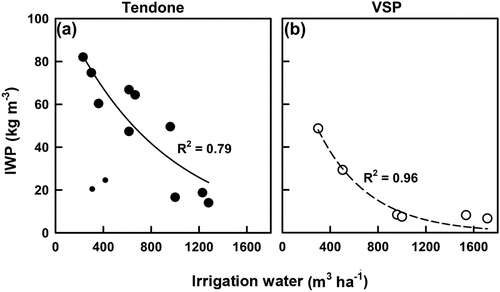
The analysis of IWP is in favour of T system which apparently contrasts with the general classification of T as a non-recommended training system under water stress, as advised in Del Zozzo et al. (Citation2024). The high IWP found in TIRR was due to the intrinsic capacity of the tendone trellising to optimize the yield per hectare once irrigated. In addition, the spatial leaf area distribution per hectare was conceivably improved in T (de Palma and Novello Citation2003; Giorio and Nuzzo Citation2011; Silvestroni et al. Citation2020) compared to the VSP likely increasing leaf WUE and reducing soil evaporation. Indeed, the T system usually displays the highest soil shade index (leaf area to soil surface area ratio), comparing with other training systems such as VSP (Giorio and Nuzzo Citation2011 and references therein). The soil shading, reducing the soil surface temperature, is expected to significantly reduce the water lost through evaporation (Breshears et al. Citation1998). Furthermore, T would not determine a significant shading between the main and the lateral leaves in the upper canopy layer, while determines a steady shading along the canopy profile contributing to minimize transpiration loss (Giorio and Nuzzo Citation2011). Thus, the tendone canopy, because of the ability to cover the whole available soil surface, optimizes the photosynthetically active radiation interception, thus putatively leading to a high photosynthate production useful for vine dry matter accumulation and berry ripening (Kliewer and Dokoozlian Citation2005).
Concerning grape quality, it is worth noting that rainfed and irrigated vineyards were comparable in terms of sugars, pH and potassium (). On the contrary, grape from rainfed vineyard displayed significantly higher total anthocyanins and total polyphenols () compared to that in irrigated. In this study, we did not measure any physiological trait to serve as proxy of vine water status (e.g., stem water potential, stomatal conductance). However, the rainfed vineyard would have suffered water limitation, at a conceivable greater extent than irrigated. Hence, the high values of anthocyanins and total polyphenols in rainfed grape are consistent with the evidence that flavonoids strongly respond to abiotic stressors such as drought, which generally stimulate secondary metabolisms (Gambetta et al. Citation2020). However, this remains to be specifically tested.
Although the training system did not differentiate the quality of bunch, additional advantages embedded in the T system to face the new challenges posed by climate change should be evoked. For example, overhead canopy training systems like pergola and tendone protect the bunches from direct sunlight, thus avoiding the excessive berry heating and skin radiative stresses that can lead to grapes with poor anthocyanin contents (Spayd et al. Citation2002) and sunburn symptoms (Rustioni et al. Citation2023).
Considering that the response of yield to increasing volume of water received follows an asymptotic pattern after an initial quasi-linear correlation (Williams et al. Citation2010), which was expanded in the T system compared to VSP (). As a result of this, the WPTOTAL in irrigated T vineyards was at a significantly higher level , confirming the influence of the training system on water use.
In the present study, the total water cost for a vineyard to get yield was expressed as WPTOTAL (EquationEquation 2(2)
(2) ), in which both irrigation volume (m3 ha−1) and annual rainfall (m3 ha−1) were considered as water sources feeding the vines. The former is managed by the grower during the vegetative season, whereas the latter is relevant in refilling the groundwater reserves (Muratoglu et al. Citation2023) and still important in supporting grapevine water demand (Campos et al. Citation2016).
Hence, increasing soil structure and function maximizing soil water infiltration (e.g., Montanaro et al. Citation2018), water rate would be in favour of high WPTOTAL throughout optimizing crop yield.
A comprehensive picture of the environmental impact of vineyard yield on water resources (WFs) needs the evaluation of both green (rain) and blue (irrigation) water. According to training system, the analysis of the volumetric WF showed that the WFgreen in the TRAIN was three times higher than that in TIRR, confirming the important role of irrigation in lowering the footprint via increasing yield (see above the discussion on IWP) within the same training system.
Furthermore, comparing the two training systems supplied by irrigation water, the TIRR was characterized by lower WFblue compared to VSPIRR highlighting the capacity of the overhead training system to optimize the efficiency of the applied water resource, as it is advisable in sustainable irrigated viticulture (Torres et al. Citation2021).
By combining the green, blue and grey WF categories in the WFtotal, a comprehensive assessment of the socio-economic footprint might be envisaged (Mekonnen and Hoekstra Citation2011 and references therein). In this study, WFtotal ranged from approx. 150 to approx. 2000 m3 of water t−1 of fresh grape across the vineyard categories, which is in line with published WFtotal in grapevine (Mekonnen and Hoekstra Citation2011; Torres et al. Citation2021). It can be noted that WFtotal in TRAIN and VSPIRR were comparable and averagely 50% higher than that in TIRR confirming the allocation of irrigation water is more sustainable that in VSP.
Conclusions
The present study contributed to characterize the water productivity of T and VSP training systems and the results expand current knowledge on water use in viticulture supporting sustainable training system selection under climate change. Data clearly showed that TIRR has had higher IWP compared to that of the VSPIRR. The socio-economic evaluation of the water used by the training system revealed the reduction of the footprint achieved at the T system when applying irrigation via increasing productivity with no impact of grape quality traits. Hence, this study integrates the set of knowledge to be evaluated for training system choice managing the trade-offs between yield, grape quality and water productivity triggered by climate change.
Supplemental Material
Download MS Word (319.5 KB)Acknowledgments
We thank the Molise winegrowers, members of the winery Cantina San Zenone, and we thank the Molise Civil Protection for kindly sharing the weather data from their stations.
Disclosure statement
No potential conflict of interest was reported by the author(s).
Supplementary material
Supplemental data for this article can be accessed online at https://doi.org/10.1080/03650340.2024.2375293
Additional information
Funding
References
- Alba V, Natrella G, Gambacorta G, Crupi P, Coletta A. 2022. Effect of over crop and reduced yield by cluster thinning on phenolic and volatile compounds of grapes and wines of ‘Sangiovese’trained to Tendone. J Sci Food Agric. 102(15):7155–7163. doi: 10.1002/jsfa.12081.
- Allan JA. 1998. Virtual water: a strategic resource. Ground Water. 36(4):545–546. doi: 10.1111/j.1745-6584.1998.tb02825.x.
- Aucelli PC, Izzo M, Mazzarella A, Rosskopf CM. 2007. La classificazione climatica della regione Molise. Boll della società geografica Ital ROMA - Ser. XII, vol. XII:615–617.
- Balbontín C, Campos I, Franck N, Calera A. 2015 June. Analyzing the effect of environmental conditions on vineyard eco-systemic water use efficiency under semi-arid field conditions. VIII International Symposium on Irrigation of Horticultural Crops 1150; 2015 June 8–15; Lleida. p. 91–96.
- Bianchi D, Grossi D, Trincani DTG, Simone Di Lorenzo G, Brancadoro L and Rustioni L. 2018. Multi-parameter characterization of water stress tolerance in Vitis hybrids for new rootstock selection. Plant Physiol And Biochem. 132(2018):333–340. doi: 10.1016/j.plaphy.2018.09.018.
- Breshears DD, Nyhan JW, Heil CE, Wilcox BP. 1998. Effects of woody plants on microclimate in a Semiarid Woodland: soil temperature and evaporation in canopy and intercanopy patches. Int J Plant Sci. 159(6):1010–1017. doi: 10.1086/314083.
- Campos I, Balbontín C, González-Piqueras J, González-Dugo MP, Neale CM, Calera A. 2016. Combining a water balance model with evapotranspiration measurements to estimate total available soil water in irrigated and rainfed vineyards. Agric Water Manage. 165:141–152. doi: 10.1016/j.agwat.2015.11.018.
- Chaves MM, Santos TP, Souza CR, Ortuno MF, Rodrigues ML, Lopes CM, Maroco JP, Pereira JS. 2007. Deficit irrigation in grapevine improves water-use efficiency while controlling vigour and production quality. Ann of Appl Biol. 150(2):237–252. doi: 10.1111/j.1744-7348.2006.00123.x.
- Del Zozzo F, Poni S, Wilkinson K. 2024. Climate change affects choice and management of training systems in the grapevine. Aust J Grape Wine Res. Volume 2024, 18. 1–18. doi: 10.1155/2024/7834357.
- de Palma L, Novello V. 2003 Sep. Leaf water use efficiency in a’tendone’trained canopy: a contribute to the ecophysiological characterization of a grapevine growing system. IV International Symposium on Irrigation of Horticultural Crops 664; 2003 September 1–6; Davis. p. 155–161.
- Dong Y, Duan S, Xia Q, Liang Z, Dong X, Margaryan K, Chen W, Goryslavets S, Zdunić G, Bert P-F. 2023. Dual domestications and origin of traits in grapevine evolution. Science. 379(6635):892–901. doi: 10.1126/science.add8655.
- Flexas J, Galmés J, Gallé A, GulíGulíAs J, Pou A, Ribas‐Carbo M, Medrano H, Medrano H. 2010. Improving water use efficiency in grapevines: potential physiological targets for biotechnological improvement. Aust J Grape Wine Res. 16:106–121. doi: 10.1111/j.1755-0238.2009.00057.x.
- Gambetta GA, Herrera JC, Dayer S, Feng Q, Hochberg U, Castellarin SD, Zhang J. 2020. The physiology of drought stress in grapevine: towards an integrative definition of drought tolerance. J Exp Bot. 71(16):4658–4676. doi: 10.1093/jxb/eraa245.
- Giorio P, Nuzzo V. 2011. Leaf area, light environment, and gas exchange in Montepulciano grapevines trained to Tendone trellising system. Plant Biosyst-An Int J Dealing With All Aspects of Plant Biol. 146(2):322–333. doi: 10.1080/11263504.2011.557095.
- Gutiérrez‐Gamboa G, Zheng W, Martinez de Toda F. 2021. Strategies in vineyard establishment to face global warming in viticulture: a mini review. J Sci Food Agric. 101(4):1261–1269. doi: 10.1002/jsfa.10813.
- Hoekstra AY. 2011. The water footprint assessment manual: setting the global standard. London: Earthscan Ltd.
- Kliewer WM, Dokoozlian NK. 2005. Leaf area/crop weight ratios of grapevines: Influence on fruit composition and wine quality. null. 56(2):170–181. doi: 10.5344/ajev.2005.56.2.170.
- Kramer PJ, Boyer JS. 1995. Water relations of plants and soils. San Diego, CA, USA: Academic press.
- Kurtural SK, Fidelibus MW. 2021. Mechanization of pruning, canopy management, and harvest in winegrape vineyards. null. 5(Suppl 1):29–44. doi: 10.5344/catalyst.2021.20011.
- Lionello P, Scarascia L. 2018. The relation between climate change in the Mediterranean region and global warming. Reg Environ Change. 18(5):1481–1493. doi: 10.1007/s10113-018-1290-1.
- Lovisolo C, Perrone I, Carra A, Ferrandino A, Flexas J, Medrano H, Schubert A. 2010. Drought-induced changes in development and function of grapevine (Vitis spp.) organs and in their hydraulic and non-hydraulic interactions at the whole-plant level: a physiological and molecular update. Funct Plant Biol. 37(2):98–116. doi: 10.1071/FP09191.
- Medrano H, Tomás M, Martorell S, Escalona JM, Pou A, Fuentes S, Flexas J, Bota J. 2015. Improving water use efficiency of vineyards in semi-arid regions. A review. Agron Sustainable Dev. 35(2):499–517.i. doi: 10.1007/s13593-014-0280-z.
- Mekonnen MM, Hoekstra AY. 2011. The green, blue and grey water footprint of crops and derived crop products. Hydrol Earth Syst Sci. 15(5):1577–1600. doi: 10.5194/hess-15-1577-2011.
- Montanaro G, Briglia N, Lopez L, Amato D, Panara F, Petrozza A, Cellini F, Nuzzo V. 2022. A synthetic cytokinin primes photosynthetic and growth response in grapevine under ion-independent salinity stress. J Plant Interact. 17(1):789–800. doi: 10.1080/17429145.2022.2102259.
- Montanaro G, Nuzzo V, Xiloyannis C, Dichio B. 2018. Climate change mitigation and adaptation in agriculture: the case of the olive. J Water Clim Change. 9(4):633–642. doi: 10.2166/wcc.2018.023.
- Muratoglu A, Bilgen GK, Angin I, Kodal S. 2023. Performance analyses of effective rainfall estimation methods for accurate quantification of agricultural water footprint. Water Res. 238:120011. doi: 10.1016/j.watres.2023.120011.
- Naulleau A, Gary C, Prévot L, Hossard L. 2021. Evaluating strategies for adaptation to climate change in grapevine production–A systematic review. Front Plant Sci. 11:607859. doi: 10.3389/fpls.2020.607859.
- OIV. 2023. State of the world vine and wine sector. Dijon. https://www.oiv.int/public/medias/8773/pptpress-conf-2022-4-def.pdf.
- Pastena B. 1990. Trattato di Viticoltura italiana. Bologna: Edizioni Agricole. p. 972.
- IPCCPörtner H-O, Roberts DC, Tignor M, Poloczanska ES, Mintenbeck K, Alegría A, Craig M, Langsdorf S, Löschke S, Möller V, Okem A, Rama B. editors]. 2022. Climate change 2022: impacts, adaptation and vulnerability. Contribution of working group II to the sixth assessment report of the intergovernmental panel on climate change 3056. Cambridge, (UK) and New York (NY) (USA): Cambridge University Press. Cambridge University Press. 10.1017/9781009325844.
- Reynolds AG, Heuvel JEV. 2009. Influence of grapevine training systems on vine growth and fruit composition: a review. null. 60(3):251–268. doi: 10.5344/ajev.2009.60.3.251.
- Rustioni L, Altomare A, Shanshiashvili G, Greco F, Buccolieri R, Blanco I, Cola G, Fracassetti D. 2023. Microclimate of grape bunch and sunburn of white grape berries: effect on wine quality. Foods. 12(3):621. doi: 10.3390/foods12030621.
- Sadras VO. 2009. Does partial root-zone drying improve irrigation water productivity in the field? A meta-analysis. Irrig Sci. 27(3):183–190. doi: 10.1007/s00271-008-0141-0.
- Silvestroni O, Lanari V, Lattanzi T, Palliotti A, Vanderweide J, Sabbatini P. 2019. Canopy management strategies to control yield and grape composition of Montepulciano grapevines. Aust J Grape Wine Res. 25(1):30–42. doi: 10.1111/ajgw.12367.
- Silvestroni O, Palliotti A, Di Lena B, Nuzzo V, Sabbatini P, Lattanzi T, Lanari V. 2020. Effects of limited irrigation water volumes on near-isohydric ‘montepulciano’vines trained to overhead trellis system. Acta Physiol Plant. 42(9):1–12. doi: 10.1007/s11738-020-03132-x.
- Spayd SE, Tarara JM, Mee DL, Ferguson JC. 2002. Separation of sunlight and temperature effects on the composition of Vitis vinifera cv. Merlot berries. null. 53(3):171–182. doi: 10.5344/ajev.2002.53.3.171.
- Steduto P, Hsiao TC, Fereres E. 2007. On the conservative behavior of biomass water productivity. Irrig Sci. 25(3):189–207. doi: 10.1007/s00271-007-0064-1.
- Tomás M, Medrano H, Escalona JM, Martorell S, Pou A, Ribas-Carbó M., Flexas J. 2014. Variability of water use efficiency in grapevines. Environ Exp Bot. 103:148–157. doi: 10.1016/j.envexpbot.2013.09.003.
- Torres N, Yu R, Martínez-Lüscher J, Kostaki E, Kurtural SK. 2021. Effects of irrigation at different fractions of crop evapotranspiration on water productivity and flavonoid composition of Cabernet Sauvignon grapevine. Front Plant Sci. 12:712622. doi: 10.3389/fpls.2021.712622.
- Vanino S, Pulighe G, Nino P, De Michele C, Falanga Bolognesi S, D’Urso G. 2015. Estimation of evapotranspiration and crop coefficients of tendone vineyards using multi-sensor remote sensing data in a Mediterranean environment. Remote Sens. 7(11):14708–14730. doi: 10.3390/rs71114708.
- Williams LE, Grimes DW, Phene CJ. 2010. The effects of applied water at various fractions of measured evapotranspiration on reproductive growth and water productivity of Thompson seedless grapevines. Irrig Sci. 28(3):233–243. doi: 10.1007/s00271-009-0173-0.
- Xyrafis EG, Gambetta GA, Biniari K. 2023. A comparative study on training systems and vine density in Santorini Island: physiological, microclimate, yield and quality attributes. OENO One. 57(3):141–152. doi: 10.20870/oeno-one.2023.57.3.7470.

